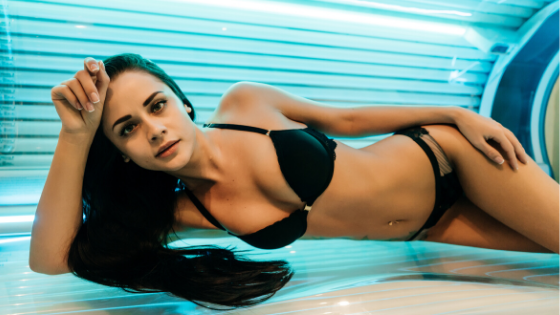
Co powinien wiedzieć klient solarium?
Share
Prowadzenie salonu solaryjnego to nie tylko jego wyposażenie, urządzenia, kosmetyki do opalania, ale przede wszystkim obsługa, dbanie o komfort, jak największe możliwe bezpieczeństwo i zadowolenie klientów. Artykuł o tym, jak ważna jest opinia klientów odwiedzających solaria możecie przeczytać TUTAJ. Dziś natomiast napiszemy o poradach dla pracowników dotyczących tego, co powinien wiedzieć klient solarium. Jak więc ułatwić naszym klientom korzystanie z solarium w jak najrozsądniejszy sposób?
Po pierwsze… pomóż nieświadomemu klientowi rozpoznać jego fototyp skóry!
Mianem fototypu określa się rodzaj indywidualnej reakcji skóry na promieniowanie słoneczne. Według klasyfikacji zaproponowanej w 1975 roku przez doktora Thomasa Fitzpatricka, dermatologa z Harvard Medical School, wyróżnić możemy sześć fototypów skóry. Wyznacznikiem dla danego fototypu jest zawartość melaniny, czyli pigmentu obecnego w skórze i odpowiedzialnego za powstawanie opalenizny. By prawidłowo określić fototyp należy zatem wziąć pod uwagę kolor włosów, oczu, a przede wszystkim rodzaj cery i jej skłonność do oparzeń oraz naturalną ochronę przed promieniowaniem.
Poniższa tabela zawiera charakterystykę sześciu fototypów. Na jej podstawie możecie określić, którym z nich jesteście, co jest bardzo pomocne w ustaleniu czasu, jaki powinniście poświęcić na opalanie, by uzyskać efekt, który będzie Was satysfakcjonował, ale co najważniejsze, pomoże to uchronić Was przed poparzeniem słonecznym. Więcej na temat fototypów skóry przeczytacie w tym artykule: https://www.onyxtan.pl/blogs/blog/jak-jest-twoj-fototyp-skory.

Lampy do opalania – jakie wybrać?
Warto zawsze przedstawić klientowi, jakie łóżka i lampy dostępne są w solarium. Wiadomo, że lampy do opalania są nieodzowną częścią każdego sprzętu opalającego. Łóżka solaryjne można wyposażyć w lampy emitujące czerwone światło, które pomagają poprawić młodzieńczy wygląd skóry, ale także inne rodzaje tak zwanych lamp hybrydowych, które nadają skórze o wiele więcej niż tylko ładną opaleniznę. Obsługa powinna wiedzieć, co komu zaproponować, kto może skorzystać ze słabszych lamp, z normą 0,3, a kto z tych mocniejszych, na przykład brązujących.
Kosmetyki do opalania w solarium, których warto używać
W solarium Wasza skóra jest poddawana cięższym warunkom niż na plaży, dlatego kosmetyk, którego akurat użyjecie musi zapewnić maksymalną ochronę oraz odpowiednio zadbać o Waszą skórę. Sprawią one, że uzyskacie zdrową i trwałą opaleniznę, a Wasza skóra będzie utrzymana w dobrej kondycji. Specjalistyczny preparat przyspiesza proces opalania jednocześnie pielęgnując skórę i sprawia, że opalenizna wygląda zdrowiej, jest ciemniejsza i szybciej widać efekty. Stosując solaryjne kosmetyki, wykorzystujecie 100% czasu opalania, ale pamiętajcie, że konieczne jest indywidualne dobranie kosmetyku do rodzaju karnacji, stopnia opalenia czy intensywności sesji w solarium. Pamiętajcie, że jeśli wystawiacie skórę na działanie lamp solaryjnych i nie używacie odpowiednich do tego kosmetyków, nie chronicie odpowiednio swojej skóry. Nie zapewniacie jej optymalnego nawilżenia, które jest wymagane podczas opalania w solarium. Zawsze przed opalaniem w solarium użyjcie profesjonalnego kosmetyku, by zapobiec wysuszaniu skóry. O odpowiednich kosmetykach do opalania w solarium pisaliśmy w tym artykule.
Jak często trzeba chodzić na solarium, aby utrzymać opaleniznę?
Nie ma recepty uniwersalnej. Jednemu wystarczy wizyta raz na dwa tygodnie, inny musi chodzić dwa razy w tygodniu. Ważna jest dawka UV i rodzaj promieni, czyli rodzaj lampy. Każdy z nas ma inną skórę i inaczej pracujące komórki produkujące pigment. Aby utrzymać kolor, w większości przypadków konieczne są promienie UVB. Ich dawka musi być wyważona i nie powinna powodować podrażnienie skóry. W większości wypadków jedna wizyta w tygodniu wystarcza, aby przez cały rok być lekko brązowym, dla ciemniejszego koloru ludzie odwiedzają solarium co piąty dzień. Personel profesjonalnego salonu solarium musi potrafić doradzić i dobrać zarówno urządzenia jak i lampy oraz czas opalania. Generalnie zaczynając opalanie najlepiej jest odwiedzać solarium 2–3 razy w tygodniu. Dla podtrzymania efektu dobrze jest opalać się od 2 do 4 razy w miesiącu.
Kiedy nie korzystać z solarium?
Niestety nie każdy może korzystać bezpiecznie z solarium, ze względu na możliwość reakcji alergicznych, czy kłopotów skórnych, jakie może wywołać imitacja promieni słonecznych. Poniższa lista dotycząca przeciwwskazań do korzystania z solarium pomoże Wam uniknąć przykrych skutków opalania.
- Jeżeli masz bardzo jasną karnację i zaliczasz się do fototypu I.
- Różnego rodzaju znamiona, przebarwienia, a także pieprzyki.
- Nadwrażliwość na promieniowanie ultrafioletowe oraz uczulenie na słońce.
- Opalanie w solarium odradza się osobom, które zmagają się z trądzikiem lub innymi chorobami skóry, a także osobom ze suchą i wrażliwą skórą.
- Niezagojone tatuaże, świeżo wykonany makijaż permanentny, duże niezagojone rany.
- Bardzo młody wiek.
- Ciąża – nie chodzi tylko o niekorzystny wpływ na skórę, która w okresie ciąży jest bardziej wrażliwa i szybciej ulega wszelkim podrażnieniom, ale chodzi głównie o prawidłowy przebieg ciąży.
- Stan podgorączkowy i gorączka, stany zapalne, grypa, a także choroby serca, układu krążenia, nerek, tarczycy, epilepsja.
- Aktywne zabiegi kosmetyczne, szczególnie głęboko złuszczające peelingi chemiczne i fizyczne, zabiegi z wykorzystaniem pochodnych retinolu, zabiegi wybielające, świeżo wykonana depilacja woskiem.
- Stosowanie kosmetyków z retinolem, kwasami hydroksylowymi (AHA, BHA), szamponu z dziegciem, dziurawca, perfum i dezodorantów bezpośrednio przed opalaniem.
- Stosowanie doustnych i zewnętrznych środków fotouczulających.
Ważne jest, aby zapoznać się z tymi przeciwskazaniami, a więcej na ten temat przeczytacie TUTAJ.
Karta Klienta solarium
W solariach często macie możliwość wyrobienia Karty Klienta, dzięki której możecie naprawdę wiele zyskać. Jeżeli nie pamiętacie na przykład tego, jak długo ostatnio się opalaliście lub w której kabinie – wszystko to zapamięta za Was system. To nie są jedyne pozytywy, ponieważ karty klienta charakteryzują się również różnymi bonusami, promocjami i gratisami, dlatego zawsze warto, aby klient uzyskał informację, czy taka kartę można wyrobić w danym solarium.
Żelazne zasady
Każdy klient musi pamiętać, że opalanie w solarium jest dozwolone od 18 roku życia. Jeżeli osoba pracująca w takim salonie ma jakiekolwiek wątpliwości, co do pełnoletności klienta, bez wahania może zapytać go o dokument tożsamości. W solarium w widocznym miejscu powinna znaleźć się informacja, że osoby niepełnoletnie nie będą obsługiwane.
Drobne informacje, ale jakże ważne!
Przed sesją w solarium nie powinno się używać dezodorantu czy perfum. Należy zmyć makijaż, a także zdjąć całą biżuterię. Związki znajdujące się w kosmetykach oraz ozdobach w kontakcie z intensywnym promieniowaniem UV mogą wywołać reakcję alergiczną. Pracownik solarium, który przyjmuje klienta na sesję opalania, powinien mu takich informacji udzielić.
Jakie macie prawa jako klienci?
- Jako klient masz prawo poprosić o położenie folii ochronnej na urządzeniu, z którego korzystasz
- W każdej chwili możesz przerwać opalanie – jeśli źle się poczujesz, wciśnij stop
- Zwracaj uwagę na komunikaty o nowych lampach – trzeba wtedy dostosować czas opalania
- Przeczytaj komunikaty w kabinie/w urządzeniu
- Jeśli w momencie uruchomienia urządzenia widzisz usterkę (np. niedziałającą lampę), zgłoś to obsłudze zanim zaczniesz się opalać; powinni wtedy zaproponować Ci inne urządzenie
Drodzy właściciele oraz pracownicy solariów, pamiętajcie, żeby każdego klienta traktować w jak najlepszy sposób, ponieważ to jego komfort i bezpieczeństwo są najważniejsze. Jeżeli klient ma jakiekolwiek pytania czy wątpliwości, należy z nim porozmawiać, doradzić, pomóc. Najważniejsze jest, aby przed skorzystaniem z solarium, pracownik ocenił stan skóry twarzy i ciała oraz przedstawił i zaproponował użycie odpowiedniego kosmetyku. Ocena stanu skóry przed zabiegiem opalania, jak i po zabiegu opalania jest bardzo ważna, ponieważ gwarantuje bezpieczne korzystanie z solarium.
